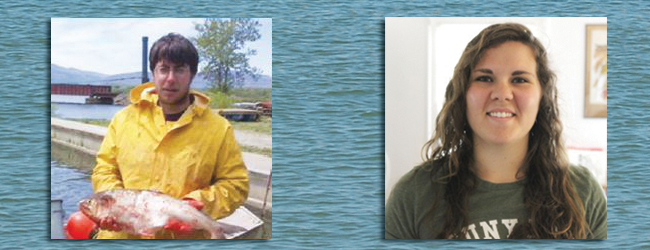
Chris Nack (at left) holds an American Shad, an important species whose populations have dwindled and whose habitat is affected by climate change. Credit: Chris Nack; Chellby Kilheffer (at right) is the second of the two Coastal Storms Fellows from New York.
—Barbara A. Branca
Stony Brook, NY, December 16, 2016 - “While growing up in a commercial fishing family on the Hudson River, I have personally seen the declines in many of the numerous fishes,” says Chris Nack, one of just six mid-Atlantic Coastal Storms Research Fellows who began the summer of 2016.
“Increased precipitation and the intensity of storms has been predicted in the northeast US as a result of climate change, making this research important in understanding the potential effects on the American Shad population, and highlighting the benefits of shoreline habitat restoration.”
Chris, a doctoral candidate at SUNY ESF, is one of two grad students from New York who were selected through a rigorous peer-review process. Virginia Sea Grant designed the mid-Atlantic Coastal Storms Fellowship, funded by the Coastal Storms Program, a NOAA initiative that brings together federal, state, and local organizations to increase resiliency to, and reduce negative impacts of coastal storms.
Chris will investigate the impacts of large storm events on the early life stages of American shad, and the importance of non-main stem habitat—the ecological or environmental areas outside of the the primary downstream segment of the Hudson River, as contrasted to its tributaries.
This project pairs restoration strategies for declining populations of the American shad with climate change adaptation.
“The one-two punch of Hurricane Irene and Tropical Storm Lee in 2011 reduced the amount of submerged aquatic vegetation (SAV) along the main channel of New York’s Hudson River, which reduced the amount of prey items and habitat available for American shad.”
Chris will investigate the importance of side channels and backwaters as nursery habitats for larval and juvenile American Shad, working closely with his mentor at New York Sea Grant, Nordica Holochuck, and academic advisor, Dr. Karen Limburg, at SUNY ESF. Dr. Limburg is currently funded by NYSG to engage stakeholders in key Hudson Valley communities regarding dam removal that may ensure greater restoration success of migratory fish populations.
Chellby Kilheffer, a second Coastal Storms Fellow from New York and also a doctoral candidate at SUNY ESF, will work with a mentor at the National Park Service as she studies factors affecting dune and vegetation recovery from Superstorm Sandy in the Otis Pike High Dune Wilderness Area on Fire Island National Seashore, New York.
In this unique one-year program, Fellows will work with academic advisors and outreach mentors who will offers guidance ranging from input on framing research question to communicating results to target audiences, and ensuring their research leads to broader societal impacts.
More Info: New York Sea Grant
New York Sea Grant (NYSG), a cooperative program of Cornell University
and the State University of New York, is one of 33 university-based
programs under the National Sea Grant College Program (NSGCP) of the
National Oceanic and Atmospheric Administration (NOAA). The NSGCP
engages this network of the nation’s top universities in conducting
scientific research, education, training and extension projects designed
to foster science-based decisions about the use and conservation of our
aquatic resources. Through its statewide network of integrated
services, NYSG has been promoting coastal vitality, environmental
sustainability, and citizen awareness about the State’s marine and Great
Lakes resources since 1971.
New York Sea Grant maintains Great Lakes offices at SUNY Buffalo, the
Wayne County Cooperative Extension office in Newark and at SUNY Oswego.
In the State's marine waters, NYSG has offices at Stony Brook University
and Stony Brook Manhattan, in the Hudson Valley through Cooperative
Extension in Kingston and at Brooklyn College.
For updates on Sea Grant activities: www.nyseagrant.org has RSS, Facebook, Twitter, and YouTube links. NYSG produces a monthly e-newsletter, "NOAA Sea Grant's Social Media Review," via its blog, www.nyseagrant.org/blog. Our program also offers a free e-list sign up via www.nyseagrant.org/coastlines for its flagship publication, NY Coastlines/Currents, which is published 1-2 times a year.